March 31st, 2010 ~ by admin
I’ve posted a fair amount about ARM processors, as today, they are in about everything. That was not always the case. ARM began with a small British company called Acorn Computers, who made various computers such as the BBC Micro (6502 based). They began developing a RISC processor in 1983 with their silicon partner VLSI. We recently received a few early versions of the ARM so here they are, with a brief history.
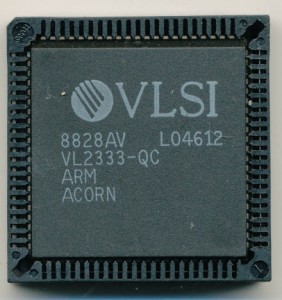
VLSI VL2333-QC 8MHz ARM1 CPU circa 1988
By 1985 they had the first working silicon of the ARM1 processor, a full 32bit design. It had around 25,000 transistors (compared with the earlier Motorola 68000 which had 70,000) so was relatively cheaper.
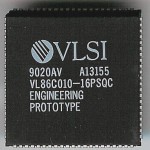
VLSI VL86C010-16PSQC 16MHz ARM2 CPU circa 1990 - Prototype
The next year the released the ARM2 processor, which added a hardware multiply instruction and ran at 8MHz. It had around 30,000 transistors.
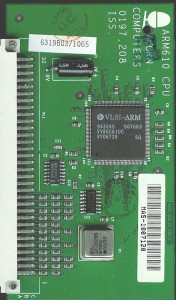
VLSI VY86C610C 30MHz ARM610 CPU circa 1994
In 1994 the ARM6 was released with higher clocks (up to 60MHz) and more features. The rest as we say is history, with many many varieties of cores available, at speeds over 1GHz, but STILL very small footprints. The ARM cores are licenses to hundreds of companies worldwide, and used in millions of devices, and it all began almost 30 years ago.
March 26th, 2010 ~ by admin
Routing internet traffic takes a vast amount of processing power. Gone are the days of dialup, where data could be processed with relative ease. Now with every connection pumping out data at rates measured in Mbits, high end devices are needed to route, inspect, and shape that traffic. These devices literally inspect, and operate on EVERY packet that goes through them, that require incredible speed to do so without affecting the speed of the data.
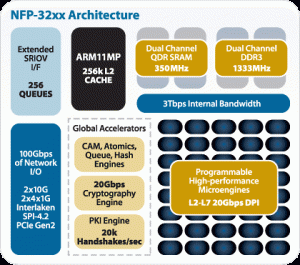
Netronome NFP-32xx block diagram
Enter such companies as Netronome, a maker of network flow processors, compatible with the Intel IXP28xx series. Each one of these processors has a 700MHz ARM CPU, as well as 8 1.4GHz RISC based Microengines are capable of delivering 56700MIPS. Expect to see more such products as companies work to meet President Obama’s National Broadband Plan.
March 16th, 2010 ~ by admin
Earlier we talked about why old designs are not going away. Today lets look at a new design. The Intel Corei7-980X Extreme. Currently one of the most powerful processors in existence. For comparisons sake I am going to loosely compare the 980X to the Motorola 68000 which arguably was the first 32 bit CPU. (yes the 980x is technically 64 bit but for the sake of comparison we’ll use it).
|
Core i7 980X |
Motorola MC68000 |
| Speed |
3600MHz |
4MHz |
| Transistors |
1.17 Billion |
40,000 |
| Process |
0.032 micron |
3.5 micron |
| Power |
130W |
1.35W |
| Voltage |
0.95V |
5V |
| Cost |
$999 |
~$30 |
Too put that in perspective you could stick over 29,000 MC68K cores on a 980X die.
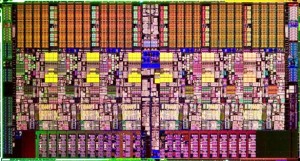
Intel Core i7-980X Processor die
So while old designs are still in wide use (and will continue to be) the new processors are nothing short of amazing.
980G Review may be found here at Hot Hardware
March 14th, 2010 ~ by admin
This topic comes up a lot. Why are old CPU designs still used? and used a lot. Every few years a company will make a statement about their new 32bit or 16bit CPU/MCU design that makes ‘migration from an 8-bit design easy’ or seeks to replace 8-bit microcontrollers entirely. It does not happen, and will not for decades.

1981 Motorola 68000 a 16/32bit CPU
8-bit processors first debuted in 1972 with the Intel 8008, so they are pushing 40 years. What many don’t realize is that 32bit processors debuted in 1979 (Motorola 68k and National Semiconductor 32k). So 32 bit is nothing new, and the same reason applies today as it did 30 years ago. Why use a Ferrari when a Chevy will do? Most designs simply don’t need that power, or complexity, 8-bits is MORE then enough to run a toaster oven, a bread machine, or your TV remote.
Embedded.com had an article talking about this issue just last week. So why do companies say that their design will replace 8-bit? It’s good PR, it gets people talking about their new processor, and thats not a bad thing.
March 6th, 2010 ~ by admin
One thing we talk a lot about is power budgets, getting as much performance out of a chip, with the least power draw possible. There is of course other budgets, such as space, or one we all know, cost.
When you buy a new Intel Core i7 processor you expect to spend $300 or so. Its common the CPU’s in phones etc cost $10-$20 each. However many applications don’t need or cannot afford that much power. In fact, most CPUs are NOT vastly powerful, or expensive. For example ST just annoucned a ARM Cortex-M3 based 32bit CPU, running at 24MHz, its cost? $0.85. TI has a whole line of its popular MSP430 16bit microcontrollers, running at up to 25MHz, they cost $0.25, yup less then a pack of gum for a fully featured processor.
March 6th, 2010 ~ by admin
 There is no denying that e-readers are a cool piece of technology. One of the things that makes them so interesting, and popular, is the unique e-ink display. A bi-stable display that only needs power to CHANGE what it is showing. These displays use VERY little power since they only need to update content ever few minutes when say reading a book on them.
There is no denying that e-readers are a cool piece of technology. One of the things that makes them so interesting, and popular, is the unique e-ink display. A bi-stable display that only needs power to CHANGE what it is showing. These displays use VERY little power since they only need to update content ever few minutes when say reading a book on them.
They do however require a controller to make them work, which is a seperate chip, and cost for an e-reader. A kindle, or Nook is certainly nice, but the cost is prohibitive to many.
Enter Freescale, they have developed the i.MX508 system-on-chip (SoC) combines a hardware Vizplex controller (e-ink controller) with a fast ARM Cortex-A8 applications processor and special e-reader power-savings modes.
End game? $99 E-readers, that will change the market
Source: EE Times








